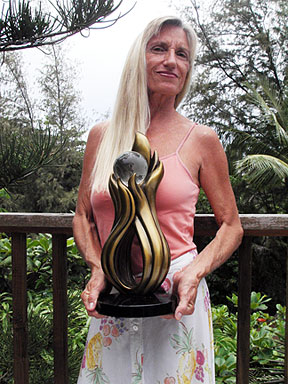 COURTESY EILEEN BORGESON This is a 2-D image of Eileen Borgeson's 3-D hologram concept art called Orbital Muse. It was created to honor people in the space industry and was featured during the Japan-U.S. Science and Technology Space Systems Programs 2006 conference held in Kona. CLICK FOR LARGE |
|
High-tech art fools the eye
Holographic sculptures made by a couple on the Big Island are bestowed as awards
WITH SCULPTURE, it's all about the space. Not just the cubic volume occupied by the work, but the "negative space" surrounding it, giving it a sense of place, mass and volume -- an infinite number of points of view.
But you can't hang it on your wall or file it with your other acquisitions and accomplishments.
A couple in rural Kapoho, on the southeastern coast of the Big Island, have figured out a work-around, however, one that could become an art form in its own right.
Eileen Borgeson, an artist and designer best known for her award sculptures -- you know, the figurines and medals given for accomplishments -- and partner Jeff Allen, an expert in holography, pooled their talents and have started making 3-D holograms of Borgeson's work.
"They look like they're coming right out of the frame," said Allen, laughing. "People keep trying to touch them and reach around behind them."
The first two works are pieces created by Borgeson to honor creative and scientific accomplishments. The "Promax Muse" is an award given by an association of marketing and promotional specialists -- hundreds were given out at an annual convention in New York in mid-June -- and the "Orbital Muse" is a piece created to honor pioneers in the space community. "Orbital Muse" holograms were a feature of the Japan-U.S. Science and Technology Space Systems Programs annual symposium held in Kona late last year.
Another piece, the "Orbit Award," also honoring space pioneers, is a faceted, polished, optical-crystal obelisk with an embossed holographic optical element, developed by Allen.
 COURTESY EILEEN BORGESON Borgeson, who is known as a sculpture artist, is shown here holding one of her pieces. CLICK FOR LARGE |
|
"When Jeff and I combined our two favorite mediums, holography and crystal, my jaded eye was awed by the rainbow explosion I saw inside!" said Borgeson, whose earlier glass and crystal work impressed the late Art Deco artist Erte, with whom she worked.
"It's working out great," said Borgeson. "We got the artist's proofs of the new holograms a few days ago, and they look exactly like the real sculptures. They're scanned by lasers on a motion-deadening, vibration-isolating stage in Los Angeles -- they absolutely cannot move when they're scanned, not even a molecule."
ALLEN AND BORGESON set up the Kapoho studio about four years ago, and have another in Mendocino, Calif., although Allen said, "We were only there a few days last year. Here, we can swim in the ocean every day. And we have DSL and county water."
The sculptures in the holograms are full-size, but the bronze originals aren't that big in the first place, about a foot tall. "The maximum best viewing is done in sunlight, otherwise they can be illuminated by a halogen light or a laser," said Allen.
Borgeson is designing a frame for the pieces, and Allen is working on adding segmented mirrors that would allow for 360-degree viewing all around a piece.
"The holograms do an amazing job of preserving texture," said Borgeson. "Down to the tiniest scratch, the patina of the metal. Many pieces of fine jewelry are hologrammed for insurance purposes.
"Do you remember when some maniac knocked the nose off of Michelangelo's 'Pieta' some years ago? The Italians were able to restore it exactly because they had hologrammed the entire statue. Technology is so cool!"

